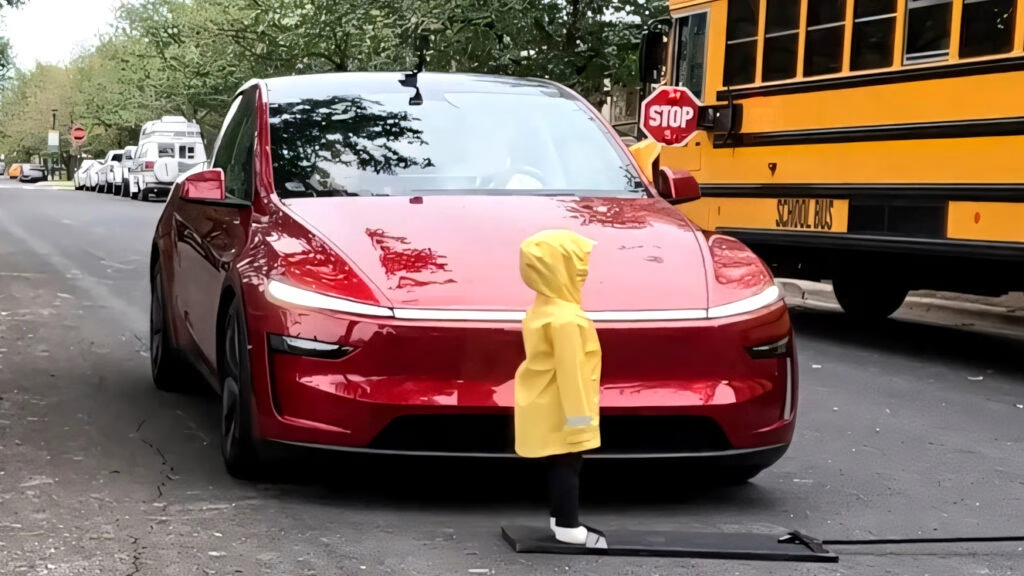A recent series of tests has put Tesla’s Full Self-Driving (FSD) technology under the microscope, raising significant concerns about its safety features. In a striking demonstration, a Tesla Model Y was put through scenarios that simulated a child running toward a school bus, only to be struck by the vehicle. This testing, conducted by The Dawn Project in collaboration with the Tesla Takedown movement, aimed to highlight what they describe as “critical safety defects” in Tesla’s semi-autonomous driving software.
What Happened During the Tests?
The tests involved a child-sized mannequin being pulled across the street while a school bus had its flashing lights and stop signs activated. The results were alarming: in eight attempts, the FSD system failed to stop for the mannequin, consistently ignoring the presence of the bus and the simulated child. According to The Dawn Project, the FSD software did not disengage or alert the driver about the collisions during any of the tests. This raises serious questions about the reliability of Tesla’s technology in critical situations.
Dan O’Dowd, the founder of The Dawn Project, expressed his outrage, stating that such software should be banned immediately. He criticized Tesla’s approach, suggesting that the company has shown negligence regarding public safety. While these claims are serious, it’s essential to understand the context in which Tesla’s FSD operates.
Understanding Full Self-Driving: What It Really Means
Tesla’s Full Self-Driving (Supervised) system is designed to assist drivers, not replace them. The name itself can be misleading; it implies a level of autonomy that the system does not possess. Tesla explicitly states that FSD is intended for use by a fully attentive driver, who must keep their hands on the wheel and be ready to take control at any moment. In the context of the tests, the lack of driver intervention during the simulated scenarios raises questions about operator responsibility. An attentive driver would likely have stopped for the school bus, even if the FSD system did not.
This distinction is crucial. While the technology aims to enhance driving safety and convenience, it still requires human oversight. The tests conducted by The Dawn Project highlight a potential gap in how drivers understand and interact with the technology, emphasizing the need for clear communication from manufacturers about the limitations of their systems.
The Broader Implications of the Tests
The fallout from these tests extends beyond just Tesla’s technology. The Tesla Takedown movement is leveraging this incident to push for broader accountability. They are advocating for events like the Electrify Expo to reconsider Tesla’s participation, arguing that the company’s practices contribute to a larger narrative of extremism and unregulated technology. Their message is clear: every Tesla sale supports not just a car company, but a financial engine that they believe fuels divisive politics.
While this perspective may resonate with some, it also raises questions about the intersection of technology, corporate responsibility, and societal values. As electric vehicles gain traction, the discourse surrounding their manufacturers becomes increasingly complex, intertwining issues of safety, ethics, and public perception.
What’s Next for Tesla and FSD?
As Tesla continues to develop its Full Self-Driving technology, the company faces mounting pressure to address these safety concerns. The tests conducted by The Dawn Project serve as a reminder of the critical importance of rigorous safety standards in the automotive industry, especially as we move towards more automated driving solutions.
The big takeaway? Full Self-Driving isn’t about perfection—it’s about smarter adjustments. As Tesla navigates these challenges, it’s essential for both the company and its drivers to engage in an ongoing dialogue about safety, technology, and responsibility. Start with one change this week, whether it’s educating yourself more about the technology or advocating for clearer safety standards, and you’ll likely spot the difference in your understanding by month’s end.

